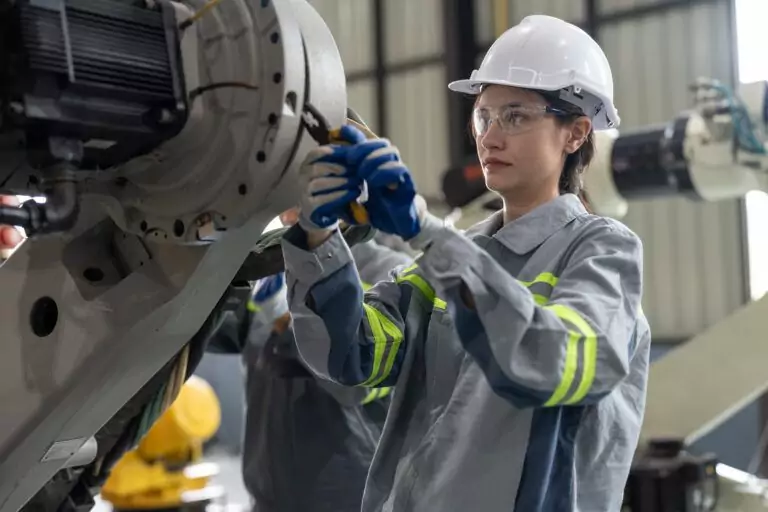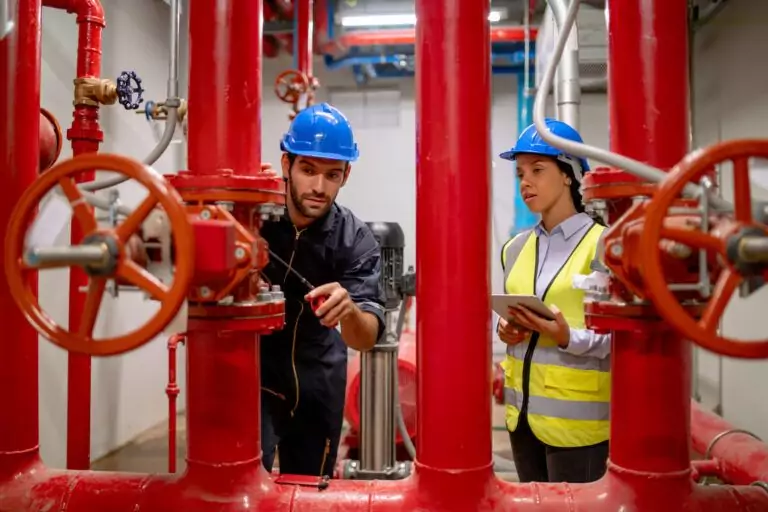Government labour market data indicates strong growth for mechanical engineering jobs through 2033. The U.S. Bureau of Labour Statistics projects 9–11% employment growth for mechanical engineers, compared to a 3–5% average across all occupations, translating to approximately 18,000–20,000 annual job openings. The Canadian Job Bank designates mechanical engineering as a moderate shortage risk, with 12,700 projected new positions through 2031.
Growth drivers include renewable energy expansion, manufacturing automation, infrastructure renewal requiring replacement of 50-60 year old facilities, and digital transformation integrating IoT and predictive maintenance. Regional variations affect opportunities significantly. Energy sector hubs in Alberta and Texas offer salary premiums of 25-35% above national averages.
Mechanical engineering stands at a transformation point where traditional skills meet emerging technologies, creating unprecedented opportunity. Understanding how automation, renewable energy, and digital systems are reshaping the profession helps you position yourself strategically for career success.
Industrial automation is reshaping factories. Renewable energy projects multiply across North America. Digital control systems replace traditional mechanical linkages. Strong government labour market projections indicate faster-than-average growth of 9-11% through 2033, compared to a 3-5% average across all occupations, according to Bureau of Labour Statistics data.
The energy transition from fossil fuels to renewable sources generates substantial demand for mechanical engineers. Infrastructure renewal, which involves replacing facilities built in the 1960s and 1970s, requires decades of work. North American manufacturers are bringing production back home through reshoring initiatives. The employment picture looks solid across multiple sectors.
Disclaimer: Job market conditions, salary data, and industry trends change frequently based on economic conditions and regional factors. All information is based on available 2025 data from government sources, including the U.S. Bureau of Labour Statistics’ Occupational Outlook Handbook and the Canadian Job Bank’s labour market information. Individual circumstances vary significantly. Always verify current information before making career decisions.
Current Employment Outlook and Growth Projections
Government projections from authoritative labour market sources indicate mechanical engineering is among the fastest-growing engineering disciplines through 2033. Multiple economic and technological factors converge to create sustained demand.
North American Growth Patterns
The U.S. Bureau of Labour Statistics projects 9-11% employment growth for mechanical engineers through 2033, which is faster than the 3-5% average growth rate across all occupations. This translates to approximately 18,000-20,000 annual job openings in the United States, including new positions resulting from industry growth and the replacement of retiring workers.
The Canadian Job Bank designates mechanical engineering as a moderate shortage risk, with labour market demand likely to exceed supply in many regions and industries. They project 12,700 new positions across Canadian provinces through 2031 based on industry employment trends and economic growth assumptions.
These projections come from government labour statisticians who analyse industry trends, technological developments, and economic factors. While no forecast guarantees specific outcomes, government sources provide more reliable data than anecdotal sources.
Key Growth Drivers
Infrastructure renewal tops the list. Facilities built in the 1960s and 1970s now approach 50-60 years of design life. Mechanical systems, including HVAC equipment, boilers, chillers, and industrial machinery, reach the end of their useful life, requiring a replacement system design.
Manufacturing expansion through reshoring initiatives adds demand for engineers designing production equipment, optimising processes, implementing automation, and supporting manufacturing operations. Technology integration creates positions that didn’t exist a decade ago. Digital twin engineers, predictive maintenance specialists, automation integration engineers, and data-driven optimisation analysts represent the evolution of mechanical engineering work.
Industries Driving Mechanical Engineering Demand
What industries hire the most mechanical engineers? According to U.S. Bureau of Labor Statistics, the top employment sectors are: (1) Manufacturing at 46% of mechanical engineers, including aerospace, automotive, and industrial machinery; (2) Engineering consulting services at 16%; (3) Research and development at 6%; (4) Government agencies at 4%; (5) Energy utilities and power generation. Manufacturing remains the largest sector, though renewable energy shows the fastest growth at 15-20% annually based on industry association data. Understanding industry distribution helps target job searches and specialisation decisions strategically.
Industry sector selection shapes career trajectory through project types, compensation levels, and long-term growth prospects. Understanding where demand concentrates helps strategic positioning.
Traditional Manufacturing’s Modern Evolution
Manufacturing employs approximately 46% of mechanical engineers, making it the largest single employment sector according to the Bureau of Labour Statistics. Modern factories differ substantially from their predecessors of the 1980s and 1990s, featuring industrial robots, automated material handling, real-time quality monitoring, and networked production equipment.
Aerospace manufacturing requires specialised expertise in lightweight materials, tight tolerances, fatigue analysis, and safety-critical design meeting stringent standards. The automotive industry transitions toward electric vehicles as major manufacturers commit to electrified lineups by 2030-2035, transforming powertrain design, vehicle architecture, and manufacturing processes.
Renewable Energy and Sustainable Engineering
The renewable energy sector shows the fastest growth amongst mechanical engineering employers. Studies suggest that employment growth will be 15-20% annually, compared to 3-5% in traditional sectors. Wind turbine systems employ mechanical engineers for component design, including gearboxes that transmit blade rotation under extreme loading, bearings that support multi-tonne rotor assemblies, and structural supports with towers exceeding 100 metres in height.
Hydrogen production through water electrolysis opens new territory requiring specialised equipment design and safety systems for highly flammable fuel. Carbon capture technology, removing CO2 from power plant emissions, requires expertise in separation systems using chemical absorption, membrane separation, or cryogenic processes.
Vista Projects’ work across 13 energy markets (from petrochemical processing to renewable energy integration) reflects how mechanical engineering supports the energy transition. Their integrated multidisciplinary approach combines mechanical, electrical, and process engineering on projects spanning carbon capture, renewable energy systems, and industrial facility modernisation.
Engineering Consulting and Professional Services
Consulting services employ approximately 16% of mechanical engineers, the second-largest employment sector, according to BLS data. Integrated multidisciplinary engineering firms serving complex industrial projects provide exposure across various specialities, working alongside electrical, civil, and process engineers on coordinated designs.
Automation, Robotics, and Controls
Mechanical engineers increasingly work with automation, creating a mechatronics specialisation combining mechanical design with electrical controls, sensors, and programming. Industrial robotics design employs mechanical engineers for end effectors (application-specific gripping devices that interface between standard industrial robots and manufactured parts). Controls knowledge becomes increasingly valuable even for mechanical engineers focused on physical system design.
Emerging Technologies Reshaping Mechanical Engineering
Technology evolution changes daily mechanical engineering work from design methods through analysis approaches to cross-disciplinary collaboration. New tools augment traditional capabilities while creating specialisations.
Digital Transformation and Asset Management
Digital twin technology creates virtual replicas of equipment, processes, or facilities, requiring engineers who understand both physical assets and digital models. Mechanical behaviour, thermodynamic performance, and failure modes combine with simulation techniques, data integration, and software platforms.
Industrial IoT sensor networks monitor mechanical equipment performance through wireless sensors measuring vibration, temperature, pressure, and flow, transmitting data to cloud platforms for analytics. Data-driven predictive maintenance using machine learning combines mechanical knowledge with analytics skills, including statistics, pattern recognition, and data science.
Advanced Materials and Additive Manufacturing
3D printing changed design constraints, enabling geometries impossible with traditional manufacturing. Metal additive manufacturing using laser powder bed fusion or directed energy deposition creates opportunities for engineers designing optimised geometries, selecting appropriate processes, and validating the structural performance of printed components.
Artificial Intelligence Integration
AI augments mechanical engineering capabilities by automating routine calculations, exploring larger design spaces, and identifying patterns in complex data beyond manual analysis. Generative design software explores thousands of possible configurations that engineers couldn’t manually consider. The software presents options whilst engineers select solutions, apply judgement, and validate results.
Skills Evolution and What Employers Value
What skills do mechanical engineers need in 2025? Essential skills combine traditional fundamentals with modern competencies: (1) Engineering fundamentals (thermodynamics, fluid mechanics, heat transfer, materials science remain absolutely essential); (2) CAD proficiency (SolidWorks, CATIA, or similar with continuous learning as features evolve); (3) Simulation capabilities (FEA and CFD now expected rather than specialised); (4) Programming skills (Python, MATLAB, or VBA for automation and data processing); (5) Controls understanding (mechanical systems increasingly integrate sensors, actuators, and programmable controllers); (6) Cross-disciplinary collaboration (projects require coordinating with electrical, instrumentation, and civil engineers); (7) Communication abilities (explaining technical concepts to non-engineers affects career advancement).
Skill requirements balance timeless engineering fundamentals with rapidly evolving competencies. Understanding this evolution guides professional development throughout careers.
Traditional Fundamentals That Remain Essential
Thermodynamics remains absolutely essential as a foundation for power generation, HVAC systems, refrigeration, and thermal equipment design. First and second laws, entropy, and energy conversion principles apply across all applications.
Fluid mechanics solves countless practical problems: piping design, HVAC systems, hydraulics, and aerodynamics. Materials science determines physical possibilities through strength, temperature limits, corrosion resistance, and manufacturing constraints. Heat transfer connects to nearly every mechanical application, from electronics cooling to industrial processes and building climate control.
These fundamentals haven’t changed in decades and provide the foundation for everything else in mechanical engineering.
New Technical Competencies in Demand
CAD software proficiency requires continuous learning as new features and platforms emerge. Finite element analysis and CFD simulation have become expected capabilities rather than specialised skills. Employers assume mechanical engineers can run basic analyses.
Programming and scripting capabilities using Python, MATLAB, or VBA enable automation, custom analysis tools, and data processing beyond manual spreadsheet work. Understanding of automation and controls helps even non-specialists as mechanical systems increasingly integrate sensors, actuators, and programmable controllers.
Professional Skills That Support Advancement
Cross-disciplinary collaboration becomes essential as projects integrate multiple engineering disciplines. Mechanical engineers work with electrical, instrumentation, civil, and structural engineers on coordinated designs for complex facilities.
Communication skills determine advancement. Explaining technical concepts to facility managers, business executives, and operations staff matters significantly. Leadership positions require influencing decisions through clear communication beyond purely technical work.
Geographic Opportunities and Regional Variations
Location significantly affects mechanical engineering careers through regional industry concentrations, salary variations reaching 40-50%, and specialisation opportunities aligned with local economic strengths.
Canadian provinces show distinct patterns. Alberta leads in energy sector employment through oil sands production, petrochemical facilities, and growing renewable energy investments. Calgary serves as Canada’s energy capital, hosting the head offices of major energy companies and engineering firms. Ontario dominates manufacturing and automotive, with approximately 40% of Canadian manufacturing employment concentrated in southern Ontario. British Columbia focuses on clean technology, renewable energy, and energy efficiency alongside an aerospace presence in Vancouver.
United States regional patterns cluster similarly. Texas leads in energy sector employment, with Houston as the global energy capital, plus a strong manufacturing presence in automotive, aerospace, and industrial machinery. California emphasises aerospace in Southern California and clean technology driven by aggressive renewable energy targets. Michigan centres on the automotive industry with a Detroit-area concentration of OEMs, suppliers, and engineering services.
Geographic location determines which industries are accessible, realistic salary levels, and whether specialisations align with regional strengths.
Specialisations With Strong Career Prospects
Specialisation choice impacts career trajectory through employment growth rates, salary premiums, and job market stability. Different paths offer distinct advantages.
Thermal systems and energy engineering create a steady demand. HVAC systems for buildings require climate control for every commercial office, school, hospital, and residential building. Industrial facilities require process cooling and clean environments. Power generation equipment requires specialised thermal knowledge for steam turbines, gas turbines, boilers, and heat recovery systems.
Manufacturing and production engineering focus on process optimisation, improving productivity through lean manufacturing, waste elimination and automation implementation. Robotics integration combines the mechanical design of fixtures and end effectors with control engineering. Programming PLCs and robot controllers provides dual expertise, increasing value.
Renewable energy systems engineering shows the fastest growth. Wind turbine mechanical systems require component design for new turbine models and maintenance management of operating turbine fleets. Hydrogen production equipment design for electrolysers opens new territory as the hydrogen economy scales up, requiring hardware engineers designing production equipment, distribution infrastructure, and end-use applications.
Automation, mechatronics, and robotics combine mechanical engineering with controls engineering for industrial automation system design. Programming PLCs, designing HMI interfaces, and implementing feedback control create high demand with premium compensation requiring diverse skill sets.
Compensation Trends and Regional Variations
What is the average mechanical engineer salary? Median mechanical engineer salaries in 2025 are approximately CAD 80,000-90,000 in Canada (Statistics Canada) and USD 102,000 in the United States (Bureau of Labour Statistics). Entry-level positions for new graduates typically start around CAD 60,000-75,000 or USD 70,000-85,000, depending on location, industry, and co-op experience. Mid-career engineers with 5-10 years and P.Eng. licensing typically earn CAD 95,000-115,000 or USD 110,000-140,000. Senior engineers with 10-15 years often reach CAD 120,000-155,000 or USD 140,000-180,000, depending on specialisation and leadership responsibilities. Renewable energy, automation, and energy sectors typically pay 15-25% premiums above manufacturing averages.
Salaries vary significantly by specialisation, location, industry, and experience, with differences reaching 30-50% between the highest and lowest-paying positions.
Specialisation in high-demand areas can drive compensation 15-25% above general mechanical engineering. Renewable energy systems, automation controls, and thermal analysis create scarcity value through specialised knowledge. P.Eng. licensing in Canada is associated with 10-15% higher compensation compared to unlicensed engineers at comparable experience levels through increased responsibility and legal authority.
Regional variations affect compensation substantially. Alberta, Calgary region and Houston, Texas area pay higher for energy sector work, reportedly 25-35% above national averages as traditional energy industry centres. The energy sector traditionally pays 15-25% above the manufacturing average, attracting engineers to capital-intensive projects, though energy markets follow boom and bust cycles, creating volatility.
Regional cost of living requires consideration. USD 85,000 in Texas provides different purchasing power than USD 85,000 in California. Factor living expenses into compensation comparisons beyond base salary figures alone.
Strategic Career Development
Strategic career positioning combines educational credentials, certifications, and multi-disciplinary experience, creating versatile capabilities valued across industries.
Bachelor’s degrees from CEAB-accredited Canadian universities or ABET-accredited U.S. programmes suffice for most positions, making industry roles accessible to bachelor’s graduates. Advanced degrees remain optional for most paths. P.Eng. licensing matters significantly for Canadian engineers, as it is legally required for independent consulting, approving designs, and advancing to senior positions in many organisations.
Studies suggest co-operative education graduates achieve employment more quickly than traditional programme graduates, though individual outcomes vary. Continuing education keeps skills current through courses, webinars, and conference attendance as engineering tools, methods, and applications evolve throughout careers.
Working across engineering disciplines increases value as modern projects require integrated solutions and system-level thinking rather than isolated discipline-specific designs. Vista Projects and similar integrated multidisciplinary engineering firms offer exposure through direct interaction with multiple specialities on coordinated project teams, providing a broader perspective than single-discipline roles.
Career success requires combining solid fundamentals with evolving technical skills. Thermodynamics, fluid mechanics, heat transfer, and materials science provide a foundation, whilst CAD proficiency, simulation capabilities, and programming skills reflect current practice. Opportunities concentrate at the intersection of traditional fundamentals and emerging technologies, including renewable energy, automation, digital twins, and predictive analytics.
Specialisation within mechanical engineering affects career trajectory by determining accessible industry sectors, salary potential, and employment stability through economic cycles. Geographic flexibility expands opportunities significantly by enabling specialisation in niche industries concentrated in specific locations.
Disclaimer: This article provides general career guidance based on 2025 government labour market data and should not be considered definitive employment advice. Job market conditions, salary ranges, and industry trends vary significantly by region, economic cycles, and individual circumstances. Growth projections represent forecasts based on current assumptions, and actual outcomes depend on numerous unpredictable factors. Always consult current official sources, verify credential requirements with licensing bodies, and seek personalised guidance from academic advisers and practising engineers before making career decisions.









